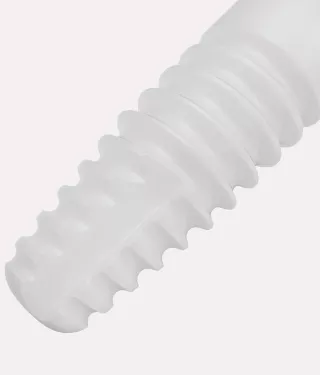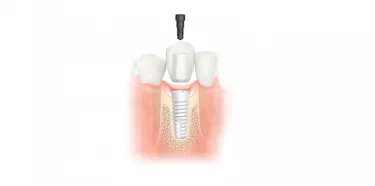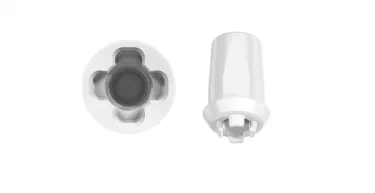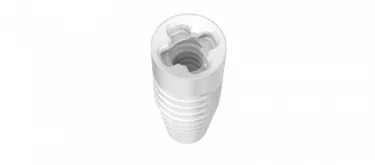
Natural esthetics and soft-tissue harmony: Growing together with a ceramic solution
For practices looking to offer their patients an alternative to titanium, Nobel Biocare has harnessed the evolution of ceramic implant solutions with NobelPearl.
Soft-tissue friendly for esthetic excellence
NobelPearl is a unique alternative to titanium. A one-hundred percent metal-free, two-piece ceramic implant solution with a cement-free internal connection, it has been designed to support natural soft-tissue appearance. Its white zirconia material is especially beneficial in patients with a thin mucosal biotype.1 Microcirculatory dynamics in peri-implant mucosa around zirconia have been shown to be comparable to those around natural teeth,2 and zirconia has also demonstrated low plaque affinity.3,4,5 In essence, NobelPearl can help patients gain the natural esthetic excellence they desire.
Cement-free flexibility
Clinicians seeking a ceramic solution for their patients might see cement as the only possibility for restoration placement. While intraoral cementation can be a viable option, the use of excess cement is known to be associated with soft-tissue inflammation and the development of peri-implant mucositis and peri-implantitis.6 To avoid this risk through screw retention, yet remain one-hundred percent metal free, NobelPearl features the innovative VICARBO® screw made of carbon-fiber reinforced polymer. In addition, NobelPearl offers greater restorative flexibility compared with one-piece or cemented ceramic implants, thanks to the two-piece, reversible, cement-free internal connection design.
Metal free, yet proven in strength
Designed for a strong ceramic-to-ceramic connection, the VICARBO® screw withstands tensile forces, while the ceramic absorbs compressive forces. This ceramic material – alumina-toughened zirconia (ATZ) – is proven to provide strength for success.7
The thread design and tapered implant shape, combined with the tapered drill protocol, have been engineered to achieve high primary stability, and the hydrophilic sand-blasted and acid-etched ZERAFIL™ surface, combined with a partially machined collar, is proven to osseointegrate.8,9 At manufacture, implants and abutments are both milled from hot isostatic-pressed (HIP) zirconium dioxide ATZ blanks – which are proven to be strong – and, at the final shaping of the implant, no sintering or finishing takes place. This enables a high level of dimensional precision and accuracy.
Embracing the evolution of ceramic solutions
The continuous development of ceramic implants by Nobel Biocare’s manufacturing partner has seen an increase in survival rate at every step.8 Now, NobelPearl is a new treatment option that follows a range of well-established workflows for two-piece implants and will be integrated into Nobel Biocare’s digital workflow. Clinicians seeking a successful start in ceramic implantology and to expand their choice for patients can gain peace-of-mind with an easy-to-adopt solution.
References
1. Cosgarea R, Gasparik C, Dudea D, et al. Peri-implant soft tissue colour around titanium and zirconia abutments: a prospective randomized controlled clinical study. Clin Oral Implants Res 2015;26(5):537-544.
2. Kajiwara N, Masaki C, Mukaibo T, et al. Soft tissue biological response to zirconia and metal implant abutments compared with natural tooth: microcirculation monitoring as a novel bioindicator. Implant Dent 2015;24(1):37-41.
3. Cionca N, Hashim D, Mombelli A. Zirconia dental implants: where we are now, and where are we heading? Periodontol 2000 2017; 73(1):241-258.
4. Scarano A, Piattelli M, Caputi S, et al. Bacterial adhesion on commercially pure titanium and zirconium oxide disks: an in vivo human study. J Periodontol 2004;75(2):292–296.
5. Rimondini L, Cerroni L, Carrassi A, et al. Bacterial colonization of zirconia ceramic surfaces: an in vitro and in vivo study. Int J Oral Maxillofac Implants 2002;17(6):793–798.
6. Wilson TG Jr. The positive relationship between excess cement and peri-implant disease: a prospective clinical endoscopic study. J Periodontol 2009;80(9):1388-1392.
7. Kohal RJ, Wolkewitz M, Mueller C. Alumina‐reinforced zirconia implants: survival rate and fracture strength in a masticatory simulation trial. Clin Oral Implants Res 2010;21(12):1345-1352.
8. Jank S, Hochgatterer G. Success rate of two-piece zirconia implants: a retrospective statistical analysis. Implant Dent 2016;25(2):193-198.
9. Chappuis V, Cavusoglu Y, Gruber R, et al. Osseointegration of zirconia in the presence of multinucleated giant cells. Clin Implant Dent Relat Res 2016;18(4):686–698.



